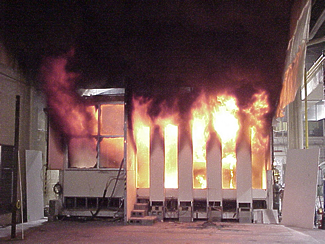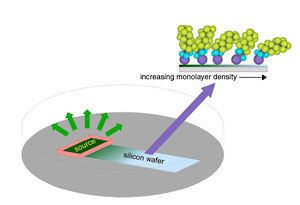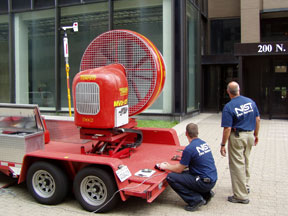| June 21, 2007

[NIST Tech Beat Search] [Credits] [NIST Tech Beat Archives] [Media Contacts] [Subscription Information]

NIST WTC Recommendations Spur New Model Building Codes
 |
NIST experiment to replicate an office fire in the World Trade Center. Tests such as this helped validate computer models of the spread rate and intensity of the fires initiated by jet fuel and fed by the office furnishings and other combustibles.*
Credit: NIST
View hi-resolution image |
Safer buildings—especially tall structures—that are more resistant to fire and more easily evacuated in emergencies are the goal of the first comprehensive set of building code changes recently approved by the International Code Council (ICC), based on recommendations from the National Institute of Standards and Technology (NIST). The recommendations were the result of the findings of NIST’s three-year investigation of the collapses of New York City’s World Trade Center (WTC) towers on Sept. 11, 2001.
The changes will be incorporated into the 2007 supplement to the ICC’s International Building Code (IBC), a model code used as the basis for building regulations promulgated and enforced by U.S. state and local jurisdictions. Those jurisdictions have the option of incorporating some or all of the code’s provisions but generally adopt most provisions.
“We fully endorse these code changes and are gratified that NIST’s WTC recommendations have stimulated fundamental and substantial changes in U.S. building codes and standards that represent a significant improvement in public safety over current practice,” says Shyam Sunder, lead WTC investigator for NIST. “NIST is committed to continuing our work to support industry and the nation’s building and fire safety officials so that the remaining recommendations also are fully considered.”
The model code changes address such areas as the fire resistance of structural components, the use of sprayed fire-resistive materials (commonly known as “fireproofing”), elevators for use by first responders, the number of stairwells, and exit path markings.
Two more model code changes will be considered for the next edition of the IBC in 2009. In the first case, a broad industry coalition is developing a proposal that would recommend structures be designed to mitigate disproportionate progressive collapse and ensure, for the first time, minimum structural integrity and robustness requirements for structures as complete systems. The second proposed code change would require the use of a nationally accepted standard for conducting wind tunnel tests routinely used for determining wind loads in the design of tall buildings. During its investigation of the collapses of the WTC towers, NIST found that wind load estimates from three separate wind tunnel tests on WTC models differed greatly.
For more information, including a Web-based system for tracking the progress toward implementing all of the NIST WTC recommendations, go to http://wtc.nist.gov.
* Image and caption added on June 22, 2007.
Media Contact: Michael E. Newman, michael.newman@nist.gov, (301) 975-3025 

NIST Fire Experts Examine Charleston Building Collapse
On June 19, 2007, the National Institute of Standards and Technology (NIST) sent four fire experts to Charleston, S.C., to gather information and examine the site of the previous night’s fire and subsequent collapse of a furniture store/warehouse located near the city’s historic district. Nine firefighters were killed in the collapse.
In Charleston, the NIST experts worked with local officials and the Bureau of Alcohol, Tobacco, Firearms and Explosives to learn more about the collapse. Based on that reconnaissance, NIST will decide if any additional study is appropriate.
NIST has more than 30 years of experience investigating building fire and structural failures. By understanding the technical causes leading to structural failures and then making that information public, NIST engineers and researchers strive to improve safety for buildings, their occupants and emergency responders.
For more information on NIST’s building fire and structural failure investigations, go to www.nist.gov/public_affairs/factsheet/bfrlinvestigations.htm.
Media Contact: Michael E. Newman, michael.newman@nist.gov, (301) 975-3025 

Catching Waves: Measuring Self-Assembly in Action
 |
Schematic of the monolayer self-assembly process studied by the NIST/NCSU team. The silicon substrate is approximately 1 x 5 cm in dimensions. The source (left) is a mixture of organosilane (OS) molecules and paraffin oil (to control the evaporation rate.) The whole system is enclosed in a Petri dish. The concentration of OS molecules is higher near the source and the ordering process initiates near this region. Molecules behind the advancing self-assembly front are relatively ordered, while molecules ahead of the front are engulfed and incorporated as the front reaches them. The molecules at the leading edge of the front are less ordered and this region becomes broader as the front advances—this is the key phenomenon measured in the experiment.
Credit: NIST
View hi-resolution image
Click to view movie of a mean field reaction-diffusion model of the monolayer self-assembly process. High-resolution measurements reveal that the S-shaped interfacial region of the self-assembly wavefront becomes progressively rougher as it advances, a feature not captured by the model. (Requires Realplayer or Windows Media Player.)
|
By making careful observations of the growth of a layer of molecules as they gradually cover the surface of a small silicon rectangle, researchers from the National Institute of Standards and Technology (NIST) and North Carolina State University (NCSU) have gained basic insights into how self-propagating self-assembly wave fronts develop and have produced the first experimental verification of recently improved theoretical models of such systems. In addition, the researchers say, the results reported in this week’s Proceedings of the National Academy of Science* should be important to understanding self-propagating chemical reactions and ordering and self-assembly phenomena in situations involving confinement, such as thin films and the porous internal geometries of many materials, such as rocks and cement.
Systems that are transformed by so-called ‘self-propagating’ or ‘autocatalytic’ wave fronts actually are very common. Diverse molecular processes, and even social processes and population dynamics, often can be described in terms of fundamental ‘entities’ that undergo changes randomly on an individual level, but at large scales exhibit some regular motion or pattern formation as they collectively move from some unstable situation to a relatively stable state. Mathematicians have developed a highly successful basic model for such processes, called mean field theory. The same basic equations describe, for example, the spread of advantageous genes in an animal population, the growth of brain tumors, wound healing, flame propagation, the spread of contagious epidemics, the spread of Neolithic farming techniques, and chemical reaction fronts and nerve propagation—all phenomena that grow outward on waves of change.
In recent years, simulations and theoretical arguments have suggested that small fluctuations can significantly influence the advance of these wavefronts as they grow. In the simple case of growth of a layer of molecules by self-assembly, this would lead to a progressive roughening of the interface between the ordered and disordered regions. This phenomenon is completely missed in the classical mean field theory, raising important questions about the applicability of these and philosophically similar models to describe propagating fronts under general conditions.
To provide experimental verification of this phenomenon in a real system, the NIST/NCSU team examined the spontaneous assembly of organosilane molecules into a monolayer film on an oxidized silicon surface. If a supply of the carbon-silicon-based molecules is placed along one edge of a treated silicon wafer, under controlled conditions, the organosilane molecules spontaneously organize themselves into a well-ordered layer, creating a carpet-like layer on the silicon that advances from the edge of the wafer at a constant velocity. The technique involved was developed in the 1990s as a simple way to create substrates with a gradually changing surface-energy gradient, a useful experimental tool for surface scientists. The system lends itself to high-resolution measurement because the process is slow enough to allow highly precise, quantitative measurements of the layer as it advances using a high-resolution synchrotron X-ray technique. The team found wavelike ordering, as expected from classical theory, but with the interface of the growing front broadened in time, as predicted by the recent theoretical modeling, but in contrast with classical theory.
The work was funded in part by the National Science Foundation.
* J.F. Douglas, K. Efimenko, D.A. Fischer, F.R. Phelan and J. Genzer. Propagating waves of self-assembly in organosilane monolayers. Proceedings of the National Academy of Science, 2007 104: 10324-10329.
Media Contact: Michael Baum, michael.baum@nist.gov, (301) 975-2763 

Fans Clear High-Rise Stairwells of Smoke
 |
NIST fire researchers Stephen Kerber and Roy McLane position a mounted fan outside the doorway of a 30-floor building in Toledo, Ohio. The positive pressure ventilation (PPV) experiment demonstrated that in a building with sprinklers, the fan, operating at 3500 rpm, is able to prevent smoke infiltration into the entire stairwell.
Credit: NIST
View hi-resolution image |
High pressure fans that direct air flow up the stairway of a burning high-rise building can increase the effectiveness of firefighters and the survivability of occupants by ridding the stairwell of smoke and toxic gases, according to a recent National Institute of Standards and Technology (NIST) report*.
The NIST analysis of 160 experiments conducted last year with small and large fans in the stairwell of a vacant 30-story office building in Toledo, Ohio, showed that the positive pressure ventilation (PPV) techniques used in small homes also worked in tall structures. The NIST engineers found that portable PPV fans, if used correctly, can both limit the amount of smoke and heat entering the stairway, and push smoke and deadly gases out of the structure. Data were collected with training smoke and pressure measurement devices.
Pressurization smoke control systems, which usually consist of mounted wall fans, have been incorporated into high-rise buildings since the 1970s. The NIST Toledo experiments, however, represented the first scientific evaluation of positive pressure ventilation technology using portable fans for buildings without built-in systems.
The NIST researchers developed several guidelines for the most effective use and positioning of portable PPV fans. The researchers also noted that the noise level near the working fans can go as high as 110 decibels—comparable to the level of a chainsaw—making communication difficult, and recommended that the fire command post be sited well away from the fans.
The NIST report urges further experiments to update current fan air flow performance standards for PPV needs. Manufacturers could certify air flow rates for specific fans. To aid fan selection, firefighter organizations also could use formulas that incorporate data for certified air flows with information related to the height or the volume of a building. NIST is continuing to study the use of PPV (see “NIST Test Fans the Flames for High-Rise Fire Safety”.) A second series of tests, to be conducted later this summer with the assistance of the Toledo Fire and Rescue Department, will use actual fire in the PPV experiments.
The Department of Homeland Security’s Science and Technology Directorate sponsored the Toledo PPV experiments. The Toledo Fire and Rescue Department, the Fire Department of New York and the Chicago Fire Department provided guidance and assistance during the experiments.
* Evaluating Positive Pressure Ventilation in Large Structures: High-Rise Pressure Experiments (NISTIR 7412) may be downloaded at www.fire.nist.gov/bfrlpubs/NIST_IR_7412.pdf.
Media Contact: John Blair, john.blair@nist.gov, (301) 975-4261 

NIST/Industry Quality Measurement Data Standard
National Institute of Standards and Technology (NIST) researchers, together with colleagues from the Automotive Industry Action Group (AIAG), key manufacturing companies, and quality software vendors, have completed work on a new data specification that will allow compliant products to store and exchange measurement data from process-monitoring instruments in a completely open and non-proprietary format. Widespread use of the new quality measurement data (QMD) specification, which defines the information exchanged between factory floor measurement instruments and Statistical Process Control (SPC) software, should provide substantial savings to quality systems users and their suppliers throughout the manufacturing sector.
Manufacturers worldwide use a wide variety of measurement instruments and systems to monitor processes and measure critical values of parts and assemblies at their factories as part of quality control. These measurement devices need to communicate with software components—from a variety of vendors—that collect and process the measurements. However, a measuring device typically cannot communicate with statistical process-control software unless both the device and the software component speak the software vendor’s proprietary language … and the 1500 to 2000 existing quality data “languages” makes transfer of information difficult. This widely recognized interoperability problem causes large and unnecessary costs to users, suppliers and vendors.
The QMD development effort represents the first time that a group of competing providers of widely used quality software have joined forces to define an open and completely non-proprietary quality data solution, based on the general XML data format, for all types of quality data—not just dimensional metrology data—in a format that captures all the necessary characterization of the data. QMD is also an entirely generic streaming data format that is measurement-system and database-schema independent—and thus can convey quality data measurements from any source to any target.
NIST supports the now two-year-old QMD development effort in a variety of ways. NIST created a QMD test suite, which is being used to verify whether a vendor’s implementation of the QMD specification actually conforms to the specification. Such testing is critical to ensure interoperability.
More information on the QMD specification is available at http://qmd.aiag.org and at www.isd.mel.nist.gov/projects/metrology_interoperability/qmd_test_suite.htm.
Media Contact: John Blair, john.blair@nist.gov, (301) 975-4261 

Quick Links
Coming Soon! Baldrige Awardees Share Successes
Leaders from the three organizations selected for the 2006 Malcolm Baldrige National Quality Award, as well as from past award recipients, will share their best practices and results at one-day regional conferences in Cleveland, Ohio, on Sept. 20, 2007, and Seattle, Wash., on Oct. 5, 2007. Participants can network with the recipients and gather valuable tips on applying the Balrdige Criteria for Performance Excellence. For more information and to register online, go to www.quality.nist.gov/2007_Regionals/Regionals.htm.

|

